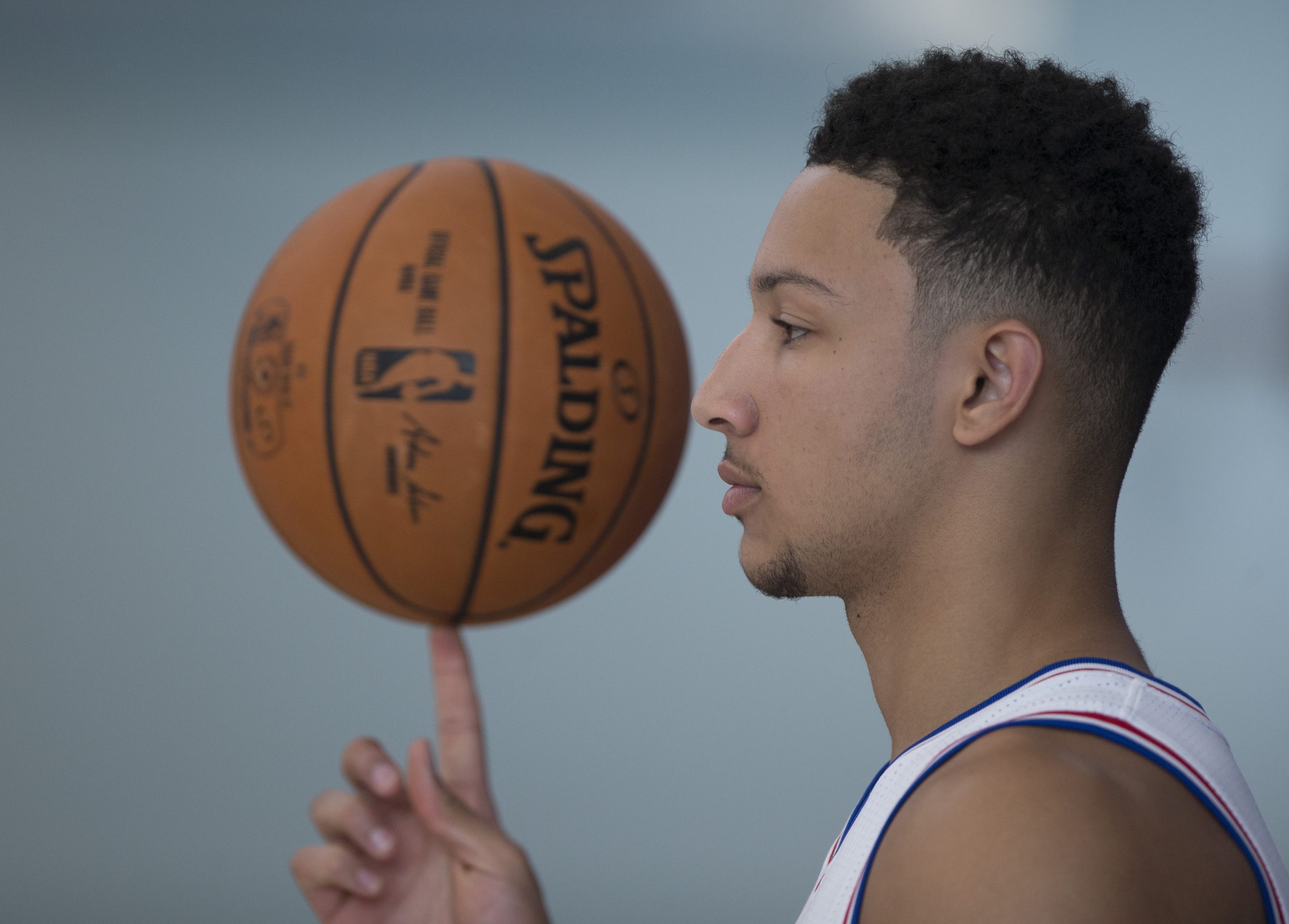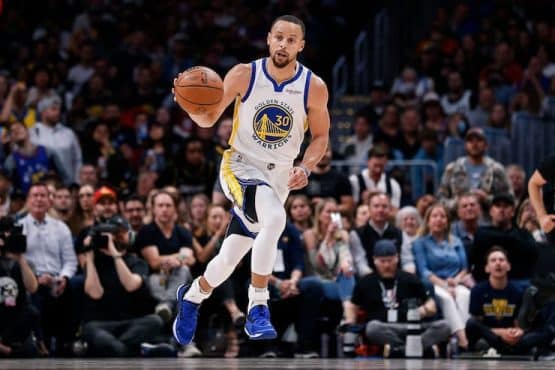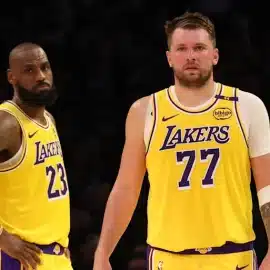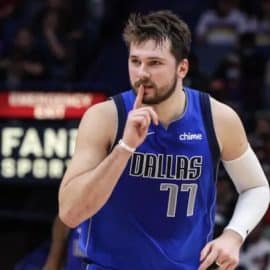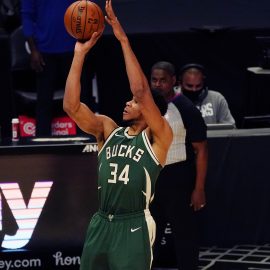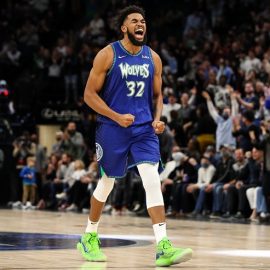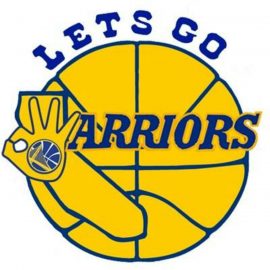When things are very close to your face, they get blurry. The human eye is incredibly versatile, able to track movement, see a wide range of color, and accurately perceive objects both near and far. But our eyes are not microscopes – once something reaches a certain level of closeness, we lose focus.
A similar principle can be applied to talent evaluation. A teenager just entering the league is hard to project. How will their body develop over the next few years? Can they address this weakness, build on this strength? Are they destined to be a bust?
The same issues with projecting players when they enter the draft exists just one year later. The object has moved away from our eye, but not enough to provide perfect clarity. Joel Embiid looked like a blurry mess one year after he was drafted, and now he might be the greatest center since Shaquille O’Neal. It’s hard to tell – but we do our best anyway.
Some quick ground rules: teams are drafting in the re-draft primarily on quality of player, more so than positional needs. The potential for players to continue improving is evaluated as of today, not then, and more weight is given to proven contributors over untapped potential. We are also including notable undrafted players who were eligible for the 2016 NBA Draft.
Finally, this draft is following the actual selection order based on trades made before and during draft night. That means that Atlanta will be selecting a player at pick 12, not Utah. In addition Oklahoma City will be taking a player at 11 instead of Orlando – we can’t know how trades were influenced by players available, or when they were agreed to, so we’re doing our best here.
One new rule for our subsequent re-drafts: we are in a separate alternate universe than the one we created over the last few weeks. That means teams are selecting in this draft as if the 2013/14/15 drafts happened as they truly did, not how they should have gone based on 2017 knowledge.
Without further ado, we look in on the Philadelphia 76ers, finally attaining that first overall pick they have fought so long and hard for.
1. Philadelphia 76ers
Original Pick – Ben Simmons, LSU
Re-draft Pick – Ben Simmons, LSU (Originally Picked 1-1)
After explaining that the re-draft will be focusing on production over upside, we have Philadelphia take the player with the least production of any lottery pick. The reason is that Simmons, without playing a single minute, has more upside than any other player has production. He is a once-in-a-generation passer, boasting the frame of a power forward and the skills of a point guard. The 76ers have no reason to take another player even with the knowledge that Simmons will miss his entire rookie year.
This reality is partly an endorsement of Simmons, but also an indictment of the class of 2016. No player submitted the sort of rookie seasons we have come to expect in recent years, from Karl-Anthony Towns and Kristaps Porzingis in 2015-16 to Andrew Wiggins in 2014-15. The rest of the lottery will be a combination of low-minute contributors on successful teams and high-minute contributors with inconsistent results on losing teams. The long-term quality of this draft is yet to be determined, but the early returns have been less than whelming.
2. Los Angeles Lakers
Original Pick – Brandon Ingram, Duke
Re-draft Pick – Jaylen Brown, Cal (1-3)
Brandon Ingram got a lot of run for the Lakers down the stretch of the season as they sat all of their veteran players. He still has a lot of work to do on building his frame, adding strength, and drilling his jumpshot until it’s automatic. He can and will do all of these things, and may end up as a dynamic two-way player who is a longtime starter on the wing for the Lakers.
The difference is that Jaylen Brown has already taken those steps. He has an NBA body, with the strength to guard opposing combo forwards and the length to contest well on closeouts. While he isn’t a knockdown shooter, he can hit corner treys as he spaces around Isaiah Thomas and Terry Rozier driving to the basket. Although he looks better by nature of being on a much better Celtics team, he has also shown he can be a rotation player in the postseason. Ingram still has a gaping floor, while Brown has shored that up already in his career. At worst, he is a two-way rotation wing in a league starved for them; at best he is a star.
3. Boston Celtics (via Brooklyn)
Original Pick – Jaylen Brown, Cal
Re-draft Pick – Thon Maker, Australia (1-10)
Full disclosure: I am buying the Thon Maker hype. He has an almost untouchable work ethic, an effusive personality, and has grown by leaps and bounds in his rookie season alone. Maker is not the same player he was in October. While much of this placement is projection, plenty of it is realized play on the court. Maker started down the stretch and in the playoffs for the Milwaukee Bucks, and demonstrated he can protect the rim, generate live-ball turnovers, and pressure shots with his prodigious length. And that’s just on defense. On offense, he hit shots from beyond the arc, then when defenders closed he flashed the ability to put the ball on the floor and drive to either finish or make pinpoint pocket passes to open teammates.
Maker played a nominal number of minutes as a starter, and has a long way to go before he is the All-Star caliber player that he could become. But with Brown gone the Celtics’ best options are guards, and with the knowledge they will be drafting Markelle Fultz this season, along with the development of Terry Rozier and Marcus Smart, Boston looks to their frontcourt instead. Maker would be a perfect complement to Al Horford and give the Celtics a different look to their roster. Boston is also one of the few organizations that can expect the best out of its developmental staff.
4. Phoenix Suns
Original Pick – Dragan Bender, Croatia
Re-draft Pick – Brandon Ingram, Duke (1-2)
While Ingram has work to do in order to grow into a long-term starter, he still has all of the tools NBA teams drool over. He’s long and athletic, can shoot the basketball, and fills a spot on the wing in a league trying to find wings anywhere. The Suns have holes at both forward spots at this point in time, but it’s reasonable to expect either Dragan Bender or Marquese Chriss to be available at eighth. Bender’s rookie year was cut short by injury, so it’s hard to identify how his still-great potential and unrealized on-court success mesh.
5. Minnesota Timberwolves
Original Pick – Kris Dunn, Providence
Re-draft Pick – Jamal Murray, Kentucky (1-6)
This is the first true disappointment of the 2016 NBA Draft, as the Timberwolves selected the man they thought was the heir apparent for Ricky Rubio. Dunn was anything but, as he struggled on both ends of the court. He certainly has time to develop into a starting-caliber point guard, but at 23 he is older than most of his peers. Dunn was supposed to be “NBA ready” and instead was worse than a number of much younger guards, including his own teammate Tyus Jones.
Instead the Timberwolves take Jamal Murray. Following a subpar start, he was a great shooter for Denver, and unleashed unexpected ballhandling skills. He’s the epitome of a third guard, with the playmaking to backup the 1 and the shooting to play off-ball at the 2. He could play behind Rubio and Zach LaVine in Minnesota and give their bench a well-needed scoring punch.
6. New Orleans Pelicans
Original Pick – Buddy Hield, Oklahoma
Re-draft Pick – Buddy Hield, Oklahoma
Buddy Hield is not the best available player left on the board. After a shaky beginning, he rebounded well, shooting more like the gunner he was expected to be. But he didn’t build on that strength in any meaningful way, and as one of the oldest players in the class he doesn’t have as much development time left. But the simple fact is that Hield, the No. 10 overall pick, and flotsam yielded the Pelicans DeMarcus Cousins. They would do that trade 10 times over if offered the chance, and in our unique reality they know that Sacramento coveted Hield. If they don’t take him here, the Kings probably would take him below and not trade with Phoenix, changing everything that was to follow.
7. Denver Nuggets
Original Pick – Jamal Murray, Kentucky
Re-draft Pick – Taurean Prince, Baylor (1-12)
The Nuggets are thrilled with Murray, who showed verve early as he injected himself into Denver’s rotation throughout their playoff push. Although the Nuggets fell short, they have plenty of confidence in Murray moving forward. With the former Kentucky guard off the board here, the Nuggets address their current largest need – a strong defensive wing to step in once Wilson Chandler and Danilo Gallinari move on. Prince forced himself into Atlanta’s rotation late in the season and showed himself to be a strong, capable player on the wing.
8. Phoenix Suns (via Sacramento)
Original Pick – Marquese Chriss
Re-draft Pick – Dragan Bender
One of the youngest picks in the draft is still bursting with upside, with plenty of potential to grow into an All-Star level talent. Not every player develops immediately, and every reason he was drafted fourth overall still exists, especially since he wasn’t given a proper rookie year due to injuries. Chriss still has plenty of potential himself, but he also received a lot more run than Bender (1743 minutes for Chriss vs. just 574 for Bender). Bender fills a need and fits their timeline.
9. Toronto Raptors (via New York)
Original Pick – Jakob Poeltl, Utah
Re-draft Pick – Skal Labissiere, Kentucky (1-28)
Looking back, the Raptors know that they didn’t catch an unlucky break – they were not anywhere close to beating the Cavaliers or making a serious run at the title. It is reasonable to look back and think they would be better off with Terrence Ross and a first-round pick than needing to pay Serge Ibaka his next big contract. Skal Labissiere turned unclear potential into exciting on-court flashes of brilliance. Whether he puts it all together is yet to be seen, but even so he’s a more valuable piece than Poeltl.
10. Milwaukee Bucks
Original Pick – Thon Maker, Australia
Re-draft Pick – Malcolm Brogdon, Virginia (2-36)
The Bucks won the 2016 draft in reality, taking a potential star at center in Thon Maker and then a starter at point guard in Malcolm Brogdon. Two starters in one draft is the sort of move only the Warriors are supposed to get away with. In our re-draft they are a victim of their own success, drafting just one of the two. Brogdon is a tough defensive guard with the ability to knock down shots from outside, and he can help move the ball in a starting lineup filled with passers. His length is a perfect fit for Kidd’s defensive scheme as well, making this a no-brainer pick for the Bucks.
11. Oklahoma City Thunder (via Orlando)
Original Pick – Domantas Sabonis, Gonzaga
Re-draft Pick – Dejounte Murray, Washington (1-29)
It seems reasonable that the Thunder directed the Magic in who to pick during last year’s draft, and at the time their man was Sabonis. Fast forward a year, and what the Thunder needed more down the stretch and in the postseason was a backup point guard, not a power forward. Murray has shown flashes in San Antonio; he’s a hyper-talented guard who can grow into a starter role long-term.
12. Atlanta Hawks (via Utah)
Original Pick – Taurean Prince, Bayor
Re-draft Pick – Juan Hernangomez, Spain (1-15)
Prince was looked at as a reach a year ago, a late-first prospect taken at 12. Jeff Teague, a proven starter at point guard and former All-Star, was too much to give up for another project wing. But Prince developed quicker than expected, turning D-League stints into a full rotation role by the playoffs.
But Prince is gone by here, as are the Hawks’ hopes that this core can get them into contention. The magical 60-win season of two years has disappeared, and with Paul Millsap hitting free agency Atlanta must either lock into an aging core or blow everything up. By taking Juan Hernangomez, they get a potential replacement for Millsap that allows them to move him prior to this past trade deadline. That’s a better long-term plan for this franchise.
13. Sacramento Kings (via Phoenix, via Washington)
Original Pick – Giorgios Papagiannis, Greece
Re-draft Pick – Patrick McCaw, UNLV (2-38)
What the Kings were thinking when they selected Papagiannis at 13th is hard to decipher. Did they truly see greatness? Most prospects refused to try out for them – did a lack of knowledge spur them to take a second-round prospect in the lottery? The Greek center hasn’t had much opportunity, but he also hasn’t shown anything. McCaw, on the other hand, has excelled in the Warriors’ rotation. If they lose Andre Iguodala in free agency, he has the makings of a replacement down the line, a long defensive wing with guard skills who generates steals and excels at cutting off the ball.
14. Chicago Bulls
Original Pick – Denzel Valentine, Michigan State
Re-draft Pick – Yogi Ferrell, Indiana (undrafted)
There are a number of options with similar profiles here for Chicago – bursts of on-court production chopped up by inconsistent minutes or flat play. Valentine was not a terrible choice here for the Bulls, but he struggled to crack the rotation for a team that desperately needed better guard play all season. Ferrell went from undrafted to the D-League to starting for the Dallas Mavericks, and immediately looks like a better point guard than Jerian Grant, Cameron Payne, Michael Carter-William or Isaiah Canann; in other words, every other Bulls point guard.
Honorable Mentions: Timothé Luwawu-Cabarrot, France (1-24) Ivica Zubac, Croatia (2-32); Paul Zipser, France (2-48); Guerschon Yabusele (1-16); Marquese Chriss, Washington (1-8); Caris LeVert, Michigan (1-20); Malik Beasley, Florida St (1-19); Tyler Ulis, Kentucky (2-34); Ron Baker/Fred Van Vleet, Wichita St (undrafted)
A trio of takeaways stand out when looking over this list. The first is the one touched on during the introduction, which is that it is extremely hard to evaluate players one season into their college careers. Many of the players are yet to turn 20 years old, and their potential almost always outweighs their production. Dragan Bender dropped due to a lack of production, but how much should we have expected out of a 19-year-old rookie who spent half of the season injured? Time will bring perspective.
Secondly, we see how much of a crapshoot talent evaluation is. Many of the players taken early are swings for “upside” and “potential” but the reality is that a team can benefit more from a solid NBA player than from an athletic marvel who will never put things together. On the other hand, taking an established four-year college player and expecting development is a difficult prospect.
Dunn and Hield failed to put things together, but Malcolm Brogdon did. Skal Labissiere plummeted in the draft, as did Dejounte Murray, but both look like future starters – and we should have known this. But does Marquese Chriss or Henry Ellenson look like they will put things together? The bottom line is that a “project” like Jaylen Brown or Thon Maker that can show real growth in their first season are a much better asset than a project who is two years away from contributing.
Finally, wings are the most valuable asset in basketball right now. Each teams needs four and wants six or seven, and finding players who won’t kill you at one end of the court is a near-impossible prospect. That the Warriors managed to get a full house is both a testament to their front office and the foundation of their success. Patrick McCaw was a steal in the second round, as was Paul Zipser, and players like Taurean Prince and Jaylen Brown outplayed their draft slot. The true winners in this year’s draft may be those who grab a wing, despite the hype surrounding the point guards.
Add The Sports Daily to your Google News Feed!
